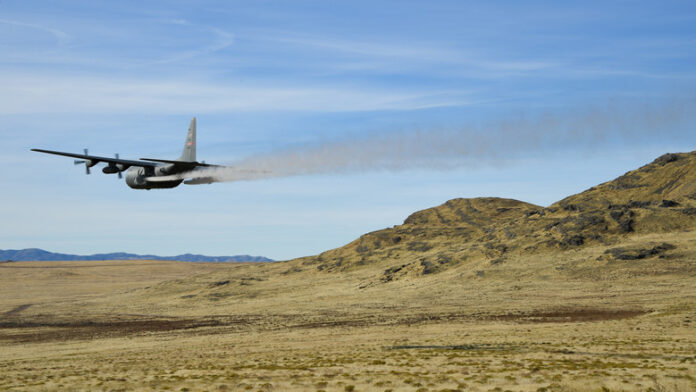The Air Force uses basic and specialized versions of the C-130 Hercules to perform a diverse number of missions, including airlift support, Antarctic resupply, aeromedical missions, weather reconnaissance, firefighting duties and aerial spray missions.
So how does the Air Force kill weeds to make fire breaks in hazardous areas of the Utah Test and Training Range? It uses a C-130 assigned to the U.S. Air Force Reserve 757th Airlift Squadron stationed at Youngstown Air Reserve Station, Ohio.

“We’re the only unit that does aerial spraying in the Air Force with the C-130,” said Lt. Col. Don Teig, 757th AS medical entomologist. “It’s tactical flying. We fly at about 100 feet to optimize dispersal.”
Equipped with spray arms and a 2,000-gallon tank, the squadron’s specialized aircraft treated six areas of the range from Oct. 21-24 with an herbicide to establish new and existing firebreaks in sections inaccessible to work crews due to potential unexploded ordnance hazards.
The pre-emergent herbicide used suppresses invasive vegetation without harming native species. It is non-toxic to humans or animals.

“We treated the areas for invasive weeds, mostly for cheatgrass, which is our biggest fire issue. Cheatgrass is a fast mover, it burns quickly,” said Russ Lawrence, Hill AFB’s Natural Resources program manager.
The size of the breaks treated ranged anywhere from 500 to 2,400 feet wide to more than five miles long.
“In theory, it creates a line where a fire will burn to and fizzle out or slow down dramatically and allow firefighters a way to get their equipment in there to fight it,” said Lawrence. “It gives firefighters a lot more confidence when fighting a fire to see that line.”
The 757th AS provides and maintains the Department of Defense’s only large-area fixed-wing aerial spray capability to control disease-carrying insects, pest insects, undesirable vegetation and to disperse oil spills in large bodies of water.
The unit’s unique mission keeps them busy year-round.
“We’ll be back in the springtime to spray bomb targets on the other side of the range so Explosive Ordnance Disposal can come in and clear out unexploded ordnance,” said Teig.





